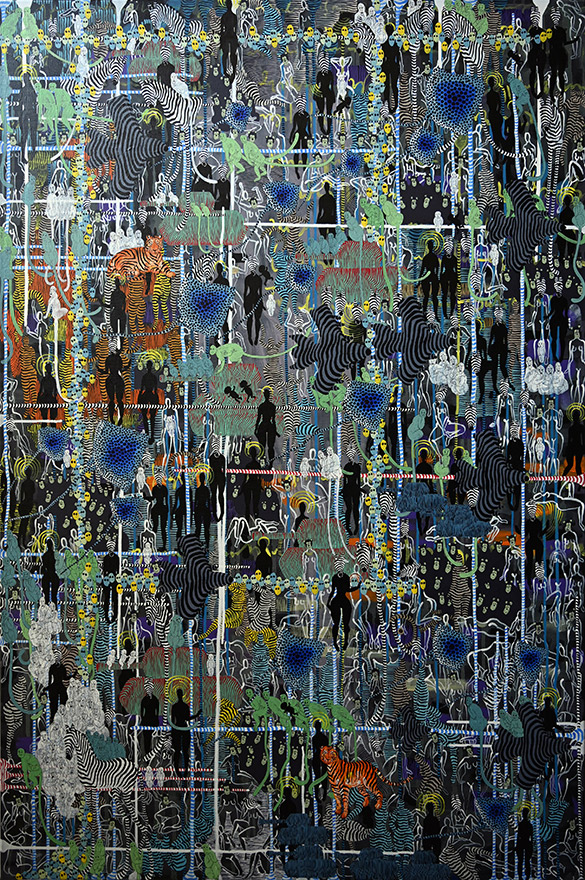
War is never justified! | We are losing our suicidal war against Nature | Triptych The World Beyond
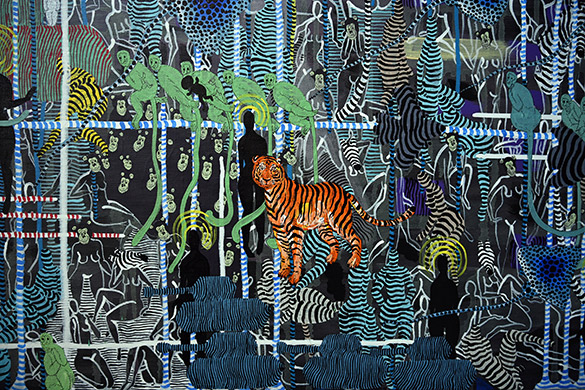
Detailansicht: Triptych: The World Beyond -7
Triptych The World Beyond
-- The original text in French --
-- The text in German --
Translated by Caroline Girod, edited by Elisa Kohl-Garrity.
The English translation made public on 20 September 2022 Berlin
-- The original text in French --
-- The text in German --
Translated by Caroline Girod, edited by Elisa Kohl-Garrity.
The English translation made public on 20 September 2022 Berlin
Someone
once asked a guide on Mount Everest if an old climber had a chance of
reaching the summit. He replied as follows: Maybe. But in the end, it
is the mountain that decides1.
This
quote perfectly illustrates the primordial role that nature plays in
our lives. She serves us as much as a spiritual master as she fulfils
her role as nurturer. Never resentful, she continues to keep humanity
alive despite the perpetual assaults of mankind. Human beings depend on
her generosity; like two sides of the same coin, they are bound to her.
However, instead of acting with her in symbiosis, they loot and destroy
her, forgetting that the death of nature will lead them to their own
extinction. Every day, like kamikazes, we wage a suicide war against
our own self, against our own ally. And it is on this most burning
theme that the artist OtGO ponders over with his work Triptych The
World Beyond (2021-2022).
As
usual, OtGO has created three very rich canvases. Very detailed, his
works invite the spectators to get as close as possible to them, even
if it means touching them with the tip of the nose. The details of
faces, expressions and movements become perceptible, and so the
paintings reveal all the treasures they contain. As we plunge our eyes
into the artist's paintings, the story begins. Wild animals and fishes
invade the canvases: different species of monkeys, tigers, zebras,
anteaters, rays. The canvases are teeming with life. However, beyond
the exotic and colorful animals, some masks appear; they are everywhere
and only bulging eyes have been depicted on the surface of the masks.
The absence of mouths, noses, but especially of emotions gives them a
chilling aspect. As for the human beings, who are sort of lifeless
black silhouettes, they are wandering, condemned, in silence. Others
are transformed into silhouettes of different colors or transparent.
While the first resemble disarticulated dolls, the second figures seem
to be disappearing from the world little by little and until they
become barely perceptible. Just like the masks, these silhouettes no
longer have faces. For the first as for the latter, the disappearance
of a body or the breaking of a soul lead to silence and death.
Alongside, the tension between the beings is palpable and their proximity seems forced. For lack of space, the animals, have to crowdthe space of human beings and remain penned up, in a tiny space. The species intermingle, and the prey rubs shoulders with their predators. Everything is overcrowded, there is no free space. Very quickly, a feeling of asphyxiation invades us, and we then feel pity for these small creatures and their lives that no longer belong to them. No tree, no flower brings cheerfulness to these paintings. One after the other, little monkeys and newborns are climbing on tanks that have taken on zebra stripes, as have planes, to camouflage themselves among the animals. The camouflage is successful, for they are only perceptible after a careful examination of the canvases. These steel behemoths are shooting blindly into a crowd of humans and animals. They are not aiming at anyone in particular; they are just shooting into space. Besides, all the species seem to be trapped in a grid formed by the shots. Perhaps this is the representation of a blind and murderous killing in which logic and common sense have vanished. Sometimes, newborn babies are being sucked into the tanks. They have just been born but are already dead, devoured by the blinding machine of power.
The more the viewer looks at the paintings, the more tension he feels. Without the use of words, Otgo's paintings cling to the viewer's mind and reveal a heartbreaking truth that rings out like a cry of alarm in the middle of the dark night. They awaken the one who looks. Several animals, including the tigers, do not hesitate to plunge their eyes into ours. They wonder about the reasons for this madness, they seek explanations. Then, they seem to ask for help. Their look becomes supplicant. We, the spectators, suddenly become those who see, but do nothing. We are silent witnesses feeling the distress of what is happening in front of our eyes. The monkey mothers are trying to save their young ones, but it is obvious that no one will be spared. Finally, we must look away, for the plaintive gaze of the beings has become too hard to bear.
However, not all the animals are afflicted. Some even display laughing features. If one looks closely, some of the monkeys show sly, malevolent smiles. They seem happy with the situation. In fact, they are part of the background, as dark as they are, and they blend in with the other depictions. They are amused by the situation and their hearts are not or no longer receptive to pain. Perhaps they belong to hell? Only they are not the only ones smiling. Some of the silhouettes have put on zebra or monkey heads and strike provocative poses. They also don’t care and are not bothered by the devastating shots of the tanks. Is this the way to show the absurdity of what is happening? Surely...
Otgo's way of evoking emotions at a crescendo is remarkable. Seen from afar, the paintings appear colorful, almost joyful, however drawing closer, another reality is revealed: joy and curiosity gradually give way to sadness and anger. Details appear and change our perception and emotions. We then put ourselves in the shoes of these beings who only seek to live freely. They are the mirror of our own existence and of our world that is slowly passing. Once separated from these canvases, we feel a change in ourselves. Something has awakened in us. Nevertheless, all may not be lost. Although dark, some of the silhouettes are emitting luminous signals around their faces. Could this not be proof, however slight, that a rebirth is possible? These figures appear like beams of light in the dark and cold landscape. They call for awakening, for change and for a more humane life for ourselves and the other beings who inhabit this planet. Hope must be found, for hope is one of the pillars of the world2.
Alongside, the tension between the beings is palpable and their proximity seems forced. For lack of space, the animals, have to crowdthe space of human beings and remain penned up, in a tiny space. The species intermingle, and the prey rubs shoulders with their predators. Everything is overcrowded, there is no free space. Very quickly, a feeling of asphyxiation invades us, and we then feel pity for these small creatures and their lives that no longer belong to them. No tree, no flower brings cheerfulness to these paintings. One after the other, little monkeys and newborns are climbing on tanks that have taken on zebra stripes, as have planes, to camouflage themselves among the animals. The camouflage is successful, for they are only perceptible after a careful examination of the canvases. These steel behemoths are shooting blindly into a crowd of humans and animals. They are not aiming at anyone in particular; they are just shooting into space. Besides, all the species seem to be trapped in a grid formed by the shots. Perhaps this is the representation of a blind and murderous killing in which logic and common sense have vanished. Sometimes, newborn babies are being sucked into the tanks. They have just been born but are already dead, devoured by the blinding machine of power.
The more the viewer looks at the paintings, the more tension he feels. Without the use of words, Otgo's paintings cling to the viewer's mind and reveal a heartbreaking truth that rings out like a cry of alarm in the middle of the dark night. They awaken the one who looks. Several animals, including the tigers, do not hesitate to plunge their eyes into ours. They wonder about the reasons for this madness, they seek explanations. Then, they seem to ask for help. Their look becomes supplicant. We, the spectators, suddenly become those who see, but do nothing. We are silent witnesses feeling the distress of what is happening in front of our eyes. The monkey mothers are trying to save their young ones, but it is obvious that no one will be spared. Finally, we must look away, for the plaintive gaze of the beings has become too hard to bear.
However, not all the animals are afflicted. Some even display laughing features. If one looks closely, some of the monkeys show sly, malevolent smiles. They seem happy with the situation. In fact, they are part of the background, as dark as they are, and they blend in with the other depictions. They are amused by the situation and their hearts are not or no longer receptive to pain. Perhaps they belong to hell? Only they are not the only ones smiling. Some of the silhouettes have put on zebra or monkey heads and strike provocative poses. They also don’t care and are not bothered by the devastating shots of the tanks. Is this the way to show the absurdity of what is happening? Surely...
Otgo's way of evoking emotions at a crescendo is remarkable. Seen from afar, the paintings appear colorful, almost joyful, however drawing closer, another reality is revealed: joy and curiosity gradually give way to sadness and anger. Details appear and change our perception and emotions. We then put ourselves in the shoes of these beings who only seek to live freely. They are the mirror of our own existence and of our world that is slowly passing. Once separated from these canvases, we feel a change in ourselves. Something has awakened in us. Nevertheless, all may not be lost. Although dark, some of the silhouettes are emitting luminous signals around their faces. Could this not be proof, however slight, that a rebirth is possible? These figures appear like beams of light in the dark and cold landscape. They call for awakening, for change and for a more humane life for ourselves and the other beings who inhabit this planet. Hope must be found, for hope is one of the pillars of the world2.
Maryna
Magnin. Mai 2022
1. John-Kabat Zinn, Où tu vas tu es, Éd. J’ai lu 1995
2. Proverbe d’Afrique du Sud
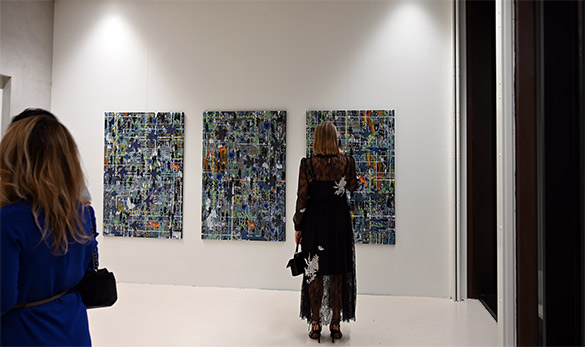
«HUNNEN» – Solo Exhibition with OtGO cova art gallery NETHERLANDS
War is never justified! | We are losing our suicidal war against Nature | Triptych The World Beyond
YouTube Link: https://youtu.be/EXMx7r02v1A
OtGO
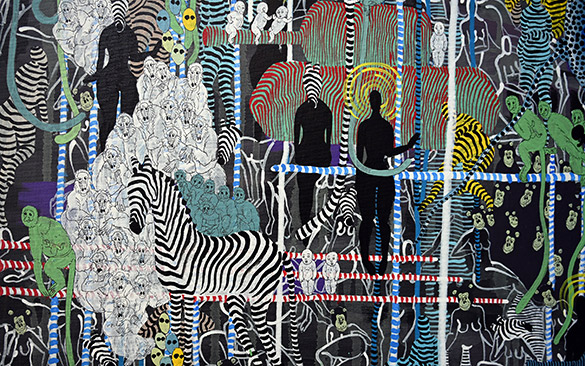
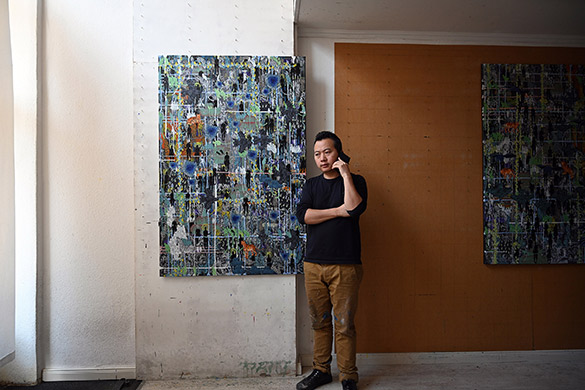 Triptych:
The World Beyond -7 and OtGO
Triptych:
The World Beyond -7 and OtGOWe are losing our suicidal war against Nature | The World Beyond | Inside the Studio | OtGO Docu.
YouTube Link: https://youtu.be/_rI_-pdpWeg
OtGO
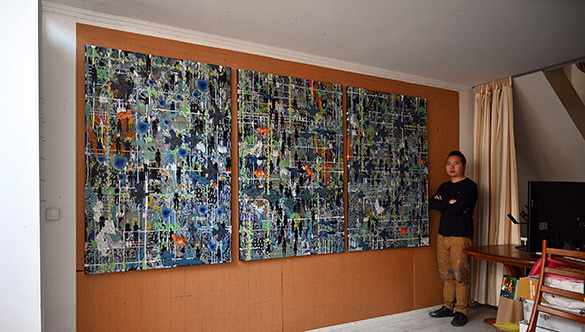 Triptych:
The World Beyond and OtGO
Triptych:
The World Beyond and OtGO